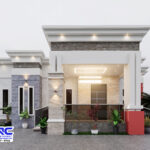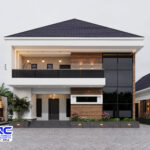It is not news that building a house in any part of Nigeria can seem daunting,
Table of Contents
Toggleyes, but it doesn’t have to be so.
Whether you’re planning to build your dream home or
an investment property it is important to understand the
process that can make it much smoother.
Bullion Rise Consult understand this need that is why, in this blog post,
we shall walk you through the stages of building a house in any part of Nigeria.
This includes from acquiring a land to moving in.
The 11 stages of building a house in Nigeria includes
- Acquiring Land
- Designing the House
- Budgeting and Financing
- Site Preparation
- Foundation and Building Construction
- Installing Utilities
- Finishing the Interior
- Further install
- Exterior Finishing
- Final Inspection
- Moving In
1. Acquiring Land
The first of course is to acquire a land.
Lands in Nigeria can be acquired through inheritance, gifts or through buying it.
Whichever way, choose the right location.
When doing so, think about how close it is to schools,
hospitals, markets, and public transport. Safety is also important.
Make sure the area has a low crime rate and is generally safe.
After that, look or find a reputable real estate agent to help you find suitable land.
Verify the land’s status with the relevant authorities
and community leaders to avoid any legal issues.
It’s always good to visit the land personally to ensure it meets your expectations.
When you are done with your due diligence,
next is to hire a professional surveyor to accurately determine the land boundaries.
This will help avoid future disputes with Neighbours or even community stakeholders.
Obtain necessary documents like the Certificate of Occupancy (C of O)
or Governor’s Consent, which legalizes your ownership of the land.
2. Designing the House
Hire a licensed architect to design the house plan for you.
Ensure the design complies with local building regulations and suits your lifestyle needs.
The design should include floor plans, elevations, and a site plan.
A structural engineer will create plans to ensure the house can
withstand environmental factors and use.
They will design the foundation, columns, beams, and roof structure.
Bullion Rise Consult further recommends that you submit the architectural and
structural designs to the relevant planning authorities for approval.
This ensures your building plans comply with local building codes and regulations.
Read – How much does a building plan cost in Nigeria?
3. Budgeting and Financing
Estimate the total cost of the project these estimate may include land,
materials, labour and other contingencies.
Obtain quotations from multiple contractors to ensure that the pricing is competitive.
Also factor in unexpected expenses that may arise during construction.
Consider hiring a project manager to oversee the construction process if you don’t have time.
They will help manage the budget, timeline and ensure that
the construction meets the required standards.
4. Site Preparation
Clear the land of any vegetation, grass, debris, or old structures.
Excavation involves digging trenches for the
foundation according to the building design.
This step is very important for a stable foundation.
Setting out involves marking the layout of the building
on the ground using pegs and strings.
This ensures that the construction follows the exact design specifications.
5. Foundation and Building Construction
The type of foundation to do for your house depends
on the soil condition and the design of the building.
In Nigeria, the common foundation types include strip, raft and pile foundations.
Excavate the trenches according to the foundation plan, then lay
reinforcement bars and pour concrete to form the foundation.
These provides a solid base for the superstructure.
This of course, is the work of construction engineers or masons.
The next building phase is to construct the walls using blocks or bricks.
Do ensure that the walls are plumb and level.
This stage includes creating openings for doors and windows.
Install lintels and beams above doors and windows.
Erect the roof structure using wood or steel.
Then the roof should be covered with roofing sheets or
tiles to protect the building from the elements.
6. Installing Utilities
Proper water supply and drainage pipes should be installed.
Ensure a proper sealing of joints to prevent leaks of any form.
Also make provisions for future expansion or modifications.
Run electrical wires throughout the house.
Install sockets, switches, and lighting fixtures.
Ensure all electrical work complies with safety
standards to avoid any form of shocks or risks.
7. Finishing the Interior
After utilities have been installed, apply plaster to the interior walls and
ceilings to create a smooth and nice surface.
This prepares the surfaces for painting and other finishes.
Choose and install flooring materials.
Options include tiles, wood, laminate, or carpet.
Ensure the flooring is durable and suits the intended use of each room.
After that, paint the walls and ceilings to your chosen colours.
Use quality paint like oil paints to ensure a long-lasting finish.
8. Further install
fixtures and fittings such as kitchen cabinets, bathroom fixtures and built-in wardrobes.
These elements add functionality and aesthetics to your house.
Read – How many months does it take to build a house in Nigeria?
9. Exterior Finishing
Plastering should be applied to the exterior walls and also be painted.
For landscaping, create gardens, lawns and walkways around the house.
It is important to note that landscaping generally improves the
aesthetics and provides outdoor spaces for relaxation and recreation.
Also build a perimeter fence and gates for your security.
In all this, choose materials that are durable and complement the house design.
10. Final Inspection
When the building is done, conduct a thorough inspection to
ensure all work meets the required standards.
Check for defects and ensure all installations function correctly before moving in.
It is recommended that you obtain an occupancy permit from the local authorities.
This certifies that the house is fit for habitation and
also complies with building regulations.
11. Moving In
Hurray! Your house is done. What next? Moving in right?
Before you do that, ensure to clean the entire house to
remove construction debris, dust and other obstructions.
Move in furniture and set up the interior.
Arrange the furniture to create a comfortable and functional living space.
Lastly, ensure to install security systems such as alarms and
surveillance cameras if possible and if you can.
These systems will definitely enhance the safety and security of your home.
Then voila!!!, your home is ready. Congratulations.
We hope that this process of building a house in Nigeria has been helpful.
If you have any questions or need further advice, feel free to send us a whatsapp message
with the whatsapp icon below.
Bullion Rise Consult will immediately respond to you.








